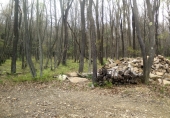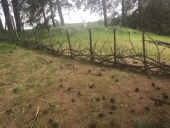
 1
1








Idle dreamer











 1
1




Clay Rogers wrote:We recently purchased a new house with some land. About 4 of the acres had been used to grow corn (row crops) by the previous owner. We want to use this same area for our garden and also our orchard. We want to transition to using cover crops and maintaining healthy soil. We are new to this though and our first question is what should be our game-plan to get this soil that was used for row crops back to being good soil? It has been fallow for a year and a half now so we're hoping any chemicals that were used have had a chance to dissipate.
So, what should our plan be to transition this soil from being used for "traditional" row crops to a system where we use cover crops?
I am a complete newb so thanks for any help you guys can provide.
"Permaculture is a philosophy of working with, rather than against nature; of protracted & thoughtful observation rather than protracted & thoughtless labour; & of looking at plants & animals in all their functions, rather than treating any area as a single-product system."-Bill Mollison

 3
3




Clay Rogers wrote:We recently purchased a new house with some land. About 4 of the acres had been used to grow corn (row crops) by the previous owner. We want to use this same area for our garden and also our orchard. We want to transition to using cover crops and maintaining healthy soil. We are new to this though and our first question is what should be our game-plan to get this soil that was used for row crops back to being good soil? It has been fallow for a year and a half now so we're hoping any chemicals that were used have had a chance to dissipate.
So, what should our plan be to transition this soil from being used for "traditional" row crops to a system where we use cover crops?
I am a complete newb so thanks for any help you guys can provide.
List of Bryant RedHawk's Epic Soil Series Threads We love visitors, that's why we live in a secluded cabin deep in the woods. "Buzzard's Roost (Asnikiye Heca) Farm." Promoting permaculture to save our planet.

 2
2




Clay Rogers wrote:We are new to this though and our first question is what should be our game-plan to get this soil that was used for row crops back to being good soil? It has been fallow for a year and a half now so we're hoping any chemicals that were used have had a chance to dissipate.
So, what should our plan be to transition this soil from being used for "traditional" row crops to a system where we use cover crops?
 1
1



























List of Bryant RedHawk's Epic Soil Series Threads We love visitors, that's why we live in a secluded cabin deep in the woods. "Buzzard's Roost (Asnikiye Heca) Farm." Promoting permaculture to save our planet.















R Ranson wrote:This is why it's so fantastic to have such a diversity of ideas. Before this thread, I never would have thought to use fungi like that. It goes on my list of 'possible tools of awesomeness for restoring soil health'.
 1
1




 1
1




I sort of agree with you John. However there are five major functional microbial groups; actinomycetes, algae, bacteria, fungi, and protozoa. You need all 5 in balance. And yes I agree, the difference between soil and "dirt" is the life in the soil, both alive and decaying. it's all part of the carbon cycle. Just clarifying that it isn't just fungi that makes the difference.John Polk wrote:
R Ranson wrote:This is why it's so fantastic to have such a diversity of ideas. Before this thread, I never would have thought to use fungi like that. It goes on my list of 'possible tools of awesomeness for restoring soil health'.
Fungi are the first step in restoring soils. See http://www.fungi.com/blog/items/mycorrhizal-management.html
Soil without fungi is called 'dirt'. Fungi is the building block that all other soil life is dependent upon.
"Permaculture is a philosophy of working with, rather than against nature; of protracted & thoughtful observation rather than protracted & thoughtless labour; & of looking at plants & animals in all their functions, rather than treating any area as a single-product system."-Bill Mollison
















List of Bryant RedHawk's Epic Soil Series Threads We love visitors, that's why we live in a secluded cabin deep in the woods. "Buzzard's Roost (Asnikiye Heca) Farm." Promoting permaculture to save our planet.
 1
1


























Clay Rogers wrote:I have learned how damaging tilling the soil can be. I'm trying to figure out though how to get the land from the rows that are established now with the remains of a corn stalk sticking up to something suitable for planting. Any ideas?
Like I said, up until recently I would till the soil and be left with nice soft soil ready for planting. Short of doing that here I'm not sure how to transition it.
List of Bryant RedHawk's Epic Soil Series Threads We love visitors, that's why we live in a secluded cabin deep in the woods. "Buzzard's Roost (Asnikiye Heca) Farm." Promoting permaculture to save our planet.
 1
1




Clay Rogers wrote:I have learned how damaging tilling the soil can be. I'm trying to figure out though how to get the land from the rows that are established now with the remains of a corn stalk sticking up to something suitable for planting. Any ideas?
Like I said, up until recently I would till the soil and be left with nice soft soil ready for planting. Short of doing that here I'm not sure how to transition it.



|
The government thinks you are too stupid to make your own lightbulb choices. But this tiny ad thinks you are smart:
A rocket mass heater heats your home with one tenth the wood of a conventional wood stove
http://woodheat.net
|






